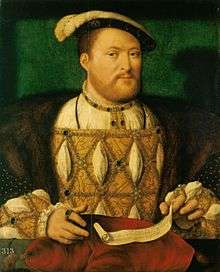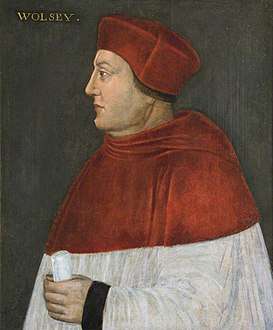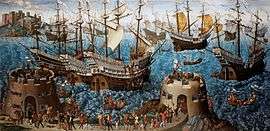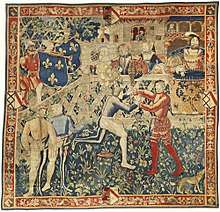Field of the Cloth of Gold




The Field of the Cloth of Gold (French: Camp du Drap d'Or) was a site in Balinghem – between Ardres in France and Guînes in the then-English Pale of Calais – that hosted a summit from 7 to 24 June 1520, between King Henry VIII of England and King Francis I of France.
The summit was arranged to increase the bond of friendship between the two kings following the Anglo-French treaty of 1514. These two monarchs would meet again in 1532 to arrange Francis's assistance in pressuring Pope Clement VII to pronounce Henry's first marriage as illegitimate. Under the guidance of English Cardinal Thomas Wolsey, the chief nations of Europe sought to outlaw war forever among Christian nations.
The site is indicated by a commemorative plaque on the D231 road (Route de Marquise) at 50°51′08″N 1°55′22″E / 50.8523°N 1.9229°ECoordinates: 50°51′08″N 1°55′22″E / 50.8523°N 1.9229°E. Though now in France, Balinghem was at the time regarded as part of England. This was probably the main reason for it as the choice of meeting place; being English territory but surrounded by France renders it as close to neutral territory as was practicable.
Background

Two entities had started to emerge as powers in Western Europe at this time: France, under Francis I, and the Habsburg Empire, under Charles V, Holy Roman Emperor. The Kingdom of England, still a lesser power, was being courted as an ally by the two major powers. The 1518 Treaty of London, a non-aggression pact between major European powers, to help resist the Ottoman expansion into southeastern Europe, had just been signed. Henry also held meetings with Charles V a month before the Field of Cloth of Gold in the Netherlands and again afterwards at Calais, Henry's only possession on the Continent.
Both Henry and Francis wished to be seen as Renaissance princes. Renaissance thinking held that a strong prince could choose peace from a place of strength. The meeting was designed to show how magnificent each court was, and how this could be a basis for mutual respect and peace between nations that were traditional enemies. Henry and Francis were also similar figures of similar age and dashing reputations, so there was almost certainly a mutual curiosity.
Everything was arranged to provide equality between the two groups. The meeting place was at the very edge of the English territory around Calais. The valley where the first meeting took place was landscaped to provide areas of equal elevation for the two national parties. The whole event was planned and executed by Cardinal Thomas Wolsey, a charismatic, eloquent master diplomat who as a papal legate had immense power in the name of the pope (Leo X at the time of the meeting). Included among the English guests were Thomas More, and Anne Boleyn's mother and sister.[1]
An earlier meeting between the kings of England and France presaged this one. From 27 to 30 October 1396, Charles VI of France and Richard II of England had met at Ardres near Calais to treat for peace during the Hundred Years' War. The scale, splendour and pageantry was comparable to the later Field of Cloth of Gold meeting held on the same site in 1520.[2]
The meeting

Each king tried to outshine the other, with dazzling tents and clothes, huge feasts, music, jousting and games. The tents and the costumes displayed so much cloth of gold, an expensive fabric woven with silk and gold thread, that the site of the meeting was named after it.
The most elaborate arrangements were made for the accommodation of the two monarchs and their large retinues; and on Henry's part especially no efforts were spared to make a great impression in Europe with this meeting. Before the castle of Guînes, a temporary palace covering an area of nearly 12,000 square yards (10,000 m2), was erected for the reception of the English king.[3] The palace was in four blocks with a central courtyard; each side was 328 feet (100 m) long. The only solid part was the brick base about 8 feet (2 m) high.[4] Above the brickwork, the 30-foot (10 metre) high walls were made of cloth or canvas on timber frames, painted to look like stone or brick. One further aspect of King Henry's retinue was the presence of two royal monkeys covered in gold leaf; these were known to have been gifts from the Ottoman Sultan Selim I and brought much laughter and merriment from Francis I as contemporary Cardinal Wolsey recounts, "The French King was overcome with much curiosity playing with those little knaves that did all they could to steal and pester his advisers, yet he willed them to be present at every banquet". The slanting roof was made of oiled cloth painted to give the colour of lead and the illusion of slates. Contemporaries commented especially on the huge expanse of glass, which made visitors feel they were in the open air. Chronicle descriptions make it clear the decorations, carved and painted had martial iconography;
The foregate of the same palace or place with great and mighty masonry by sight was arched, with a Tower on every side of the same portered by great craft, and inbatteled was the gate and Tower, and in the fenesters, and windows, were images resembling men of warre redie to cast great stones: also the same gate or Tower was set with compassed images of ancient Princes, as Hercules, Alexander and other, by entrayled worke, richly limned with gold and Albyn colours, .... also the tower of the Gate as seemed was built by great masonry, ... for the sundrie countenances of every Image that their appeared, some shooting, some casting, some ready to strike, and firing of gonnes, which shewed very honourably.
— Grafton's Chronicle, or Chronicle at Large 1569[5]
The building was decorated in the most sumptuous fashion and furnished with a profusion of golden ornaments.[3] Red wine flowed from the two fountains outside. The chapel was served by 35 priests. Composer Jean Mouton was most likely in charge of the musical production by Francis I; the French royal chapel had one of the finest choirs in Europe, and contemporary accounts indicated that they "delighted their hearers."[6] The wooden ceiling for one of the tents may later have been installed in the New Chapel at Ightham Mote where, with its colours faded, one with appropriate features can still be seen.[7] Musical production on the English side was probably led by composer William Cornysh the Younger, master of the Royal Chapel for Henry VIII.[8]
Some idea of the size of Henry's following may be gathered from the fact that in one month 2200 sheep and other viandes in a similar proportion were consumed. In the fields beyond the castle, 2800 tents were erected for less distinguished visitors.[3]
Journeying from Calais, Henry reached his headquarters at Guînes on 4 June 1520, and Francis took up his residence at Ardres. After Cardinal Wolsey, with a splendid train, had visited the French king, the two monarchs met at the Val d'Or, a spot midway between the two places, on 7 June.[3]
The following days were taken up with tournaments, in which both kings took part.[3] There were banquets in which the kings entertained each other's queens. The many other entertainments included archery displays and wrestling between Breton and Cornish wrestlers.

Wolsey said Mass and the two sovereigns separated on 24 June, Corpus Christi. The painting depicts a dragon flying overhead and this could be interpreted to mean that the Mass itself was interrupted by a mysterious event thought to be a dragon or salamander flying over the congregation. The superstitious would have viewed this as a great portent, but it was probably a firework accidentally or deliberately set off. Alternatively the dragon in the painting could be interpreted as symbolic. The sermon was read by Richard Pace, an intimate friend of Erasmus. Wolsey gave a general indulgence for all present.
Consequences
This meeting made a great impression on contemporaries, but its political results were very small.[3] While the carefully established rules of the tournament stated that the two kings would not compete against each other, Henry surprisingly challenged Francis in a wrestling match, but it turned sour for Henry when he quickly lost.[9]
Relations between the two countries worsened soon after the event when Cardinal Wolsey arranged an alliance with Charles V, who declared war on France later that year commencing the Italian War of 1521–26.
List of participants
A record of the list of participants survives in at least two places: in the Rutland Papers[10] and in the Letters and Papers, Foreign and Domestic, of King Henry VIII,[11] catalogued as Letters indented specifying, in accordance with the treaty of 12 March 1519, the number and rank of the lords, ladies and gentlemen to attend the King and Queen at the interview with Francis I. The latter source lists the following:
For King Henry VIII
"For the King: The cardinal of York, with 300 servants, of whom 12 shall be chaplains and 50 gentlemen, with 50 horses; one archbishop with 70 servants, of whom 5 shall be chaplains and 10 gentlemen, with 30 horses; 2 dukes, each with 70 servants, 5 to be chaplains and 10 gentlemen, with 30 horses. 1 marquis with 56 servants, 4 to be chaplains and 8 gentlemen; 26 horses. 10 earls, each with 42 servants, 3 to be chaplains and 6 gentlemen; 20 horses. 5 bishops, of whom the bishop of Winchester shall have 56 servants, 4 to be chaplains and 8 gentlemen; 26 horses;—each of the others, 44 servants, 4 to be chaplains and 6 gentlemen; 20 horses. 20 barons, each to have 22 servants, 2 to be chaplains and 2 gentlemen; 12 horses. 4 knights of the order of St. George, each to have 22 servants, 2 to be chaplains and 2 gentlemen; 48 horses. 70 knights, including Sir William Mathew, grandson of Sir David Ap Mathew of Wales. Each knight to have 12 servants, one to be a chaplain; 8 horses. Councillors of the long robe; viz., the King's secretary, the vice-chancellor, the dean of the Chapel, and the almoner, each to have 12 servants, one a chaplain, and 8 horses. 12 King's chaplains, each with 6 servants and 3 horses. 12 serjeants-at-arms, each with 1 servant and two horses. 200 of the King's guard with 100 horses. 70 grooms of the chamber, with 150 servants and 100 horses among them; 266 officers of the house, with 216 servants and 70 horses; 205 grooms of the stable and of the armories, with 211 horses. The earl of Essex, being earl marshal, shall have, beside the number above stated, 130 servants and 100 light horses. Sum total of the King's company, 3,997 persons and 2,087 horses".
For Queen Catherine of Aragon
"For the Queen: 1 duchess, with 4 women, 6 servants and 12 horses; 10 countesses, with 3 women and 4 servants, and 8 horses each; 12 baronesses, with 2 women, 3 servants and 6 horses each. 20 knights' ladies, with 1 woman, 2 servants and 4 horses each; 14 ladies, with 1 woman, 2 servants and 3 horses each; 6 ladies of the chamber, with 1 servant and 2 horses each; 1 earl, with 42 servants, 3 to be chaplains and 9 gentlemen; horses 20. 3 bishops, to have 44 servants, 4 to be chaplains and 6 gentlemen; horses 60. 4 barons, with 22 servants, 2 to be chaplains and 2 gentlemen; horses 48. 30 knights, with 12 servants, 1 to be a chaplain; horses 240; 6 chaplains with 3 servants and 2 horses each. Grooms 50, officers of the King's chamber, with 20 servants and 30 horses; officers of the King's stable 60, with 70 horses. Sum total of the Queen's company, 1,175 persons and 778 horses.
Commissioners
"Names of those appointed to attend the king of England at the Congress:
Commissioners to oversee followers of French King
Commissioners appointed to oversee those who shall accompany the king of France:—The earl of Essex, Lord Abergavenny, Sir Edw. Ponynges, Sir Rob. Wingfield.
Commissioners to give orders to the gentlemen
Commissioners to give orders to the gentlemen:—Sir Edw. Belknapp, Sir Nich. Vaux, Sir John Peche, Sir Maurice Berkeley.
Commissioners to give orders to the foot soldiers
Commissioners to give orders to the foot soldiers:—Sir Weston Browne, Sir Edw. Ferrers, Sir Rob. Constable, Sir Ralph Egerton, Sir Thomas Lucy, Sir John Marney.
Other attendees
At the embracing of the two kings
To ride with the king of England at the embracing of the two kings:—The Legate, archbishop of Canterbury, dukes of Buckingham and Suffolk, marquis of Dorset. Bishops:—Durham, Armagh, Ely, Chichester,[12] Rochester, Exeter, Hereford. Earls:—Stafford, Northumberland, Westmoreland, Shrewsbury, Worcester, Devonshire, Kent, Wiltshire, Derby, Kildare. Barons:—Maltravers, Montagu, Herbert, the grand prior of St. John of England, Roos, Fitzwalter, Hastings, Delaware, Dacre, Ferrers, Cobham, Daubeney, Lumley, Sir Henry Marney, Sir Wm. Sandys, Thomas Boleyn, Lord Howard.
Order of procession
The servants of the king of England shall march next their King, preceded by the nobles and gentlemen of the Legate, who shall follow the gentlemen of the other lords. The King's guard to follow him in their accustomed places.
Attendants of King Francis I
At meeting of two kings
The names of those who will be with the French king when he meets the king of England: the king of Navarre; dukes of Alençon, Bourbon, Vendosme and Lorraine; count of Saint Pol; prince de la Roche Suryon; count of Dreux and Rhetel, Sieur Dorval and governor of Champaigne; count of Benon, sieur de la Tremoille, first Chamberlain, admiral of Guyenne and governor of Burgundy; count of Estampes and Caravats, sieur de Boysy, grand master and governor of the Dauphin; Bonnyvet, admiral of France, Lautrec, La Palisse and Chastillon, marshals; count of Guyse, brother of the duke of Lorraine; the bastard of Savoy, count of Villars and Beaufort, governor of Provence; count de Laval; mons. de Chasteaubriant; count of Harcourt; princes of Orange and Tallemont; mons. de Nevers; mons d'Esparrox, lieutenant of Guyenne, and count of Montfort; Mess. de Lescun and Montmorency; le Grand Escuyer; counts de la Chambre, Tonnerre, Brienne, Joigny, Bremie and Mont Reuel; mons. d'Albret. The other knights of the Order. The king's household, 200 gentlemen; St. Vallier and the grand seneschal of Normandy, captains. 400 archers of the guard, and 4 captains; 100 Swiss, De Florenges, captain; maîtres d'hôtel, pannetiers, valets, &c.; gentlemen of the council and of the finances. The other pensioners will remain in their houses. Francis will bring with him the above company, if the king of England thinks it suitable; but if not, he will diminish it. These noblemen will only have with them about 200 horses.
English attendants of English King
Noblemen's names that shall accompany the French (sic) (English?) king at the meeting at Calais. The King's Council. My lord Cardinal. The Privy Seal. The bishops of Lincoln, Norwich, Hereford and Rochester. The dukes of Norfolk and Buckingham. The marquis Dorset. The earls of Surrey, Shrewsbury, Worcester, Derby, Northumberland, Essex and Wiltshire. The lords of St. John, Burgevenny, Devonshire, Montague, Mounteagle, Cobham, Ferys, Fitzwalter, Dudley, Dacres of the South, Darcy, Conyers, Audeley, Broke and Fitzwarren. The deans of the Chapel and of Paul's. The archdeacon of Richmond. The dean of Salisbury. Dr. Syxtyne. Dr. Clark. The abbots of Glastonbury, Westminster, Bury and Winchecombe. All knights and others of the King's council. The secretaries in Latin, French and English. The clerks of the Privy Seal and Signet. The heralds. The officers of the household. The minstrels.
County representatives
- Bedford:—Sir John St. John, Wm. Gascoyn, Robt. Spenser, Lenthorp, Wm. Fitzjeffrey, Geo. Harvy.
- Buckingham:—Sir Andrew Windsor, Sir Rauf Verney, junr., John Cheynye, Sir Wm. Hampden, John Gyfford.
- Warwick:—Lord Dudley, Sir Gilbert Talbot, junr., Geo. Throgmorton, Sir Edward Belknap, Edw. Gryvill, Sir John Burdute, Sir Thos. Lucy, Sir Edw. Ferys, Edw. Conway.
- Lincoln:—Lord Willoughby, Sir Christopher Willoughby, Sir John Husey, Sir Geoffrey Paynell, Sir Miles Bushe, Sir Rob. Scheffeld, Sir Wm. Tirwytt, Wm. Askew, Geo. Fitzwilliam, Sir Rob. Dymocke, Wm. Hansard.
- Essex:—The Earl of Essex, Lord FitzWalter, Sir Henry Marny, Sir John Raynysford, Sir Thos. Tyrell, Sir Ric. Lewys, Sir Roger Wentworth, Wm. Pirton, Sir Whitstan Browne, John Marnye.
- Sussex:—The Duke of Norfolk, the Earl of Surrey, Lord Matravers, Sir Thos. West, Lord Dacre, Sir David Owen, Sir Godard Oxynbridge, Wm. Ashbornham, Sir Edw. Lewkenor, Sir John Dawtry.
- Berkshire:—Sir Geo. Forster, Sir Thos. Fetyplace, Sir Wm. Essex, Sir Richard Weston, Hen. Bridges, John Cheyny, Ric. Noreys, Ric. Hampden.
- Hertford:—Lord Barnesse, Sir Edw. Benstede, Thos. Clyfford.
- Gloucester:—The Duke of Buckingham, Sir Maurice Barkeley, William Denys, Sir Wm. Kyngston, Sir Christopher Baynham, Sir John Hungerford, Sir Edw. Wadham, Sir John Brydges.
- Cornwall:—Lord Broke, Sir John Arundell, Sir Pers Eggecombe, Sir Roger Graynefeld,[13] Sir John Trevenyan.
- Suffolk:—Sir Thos. Bolayn, Sir Rob. Brandon, Sir Rob. Drury, Sir Ant. Wyngfeld, Sir Wm. Walgrave, Sir Ric. Wentworth, Sir John Shelton, Sir Arthur Hopton, Sir Rob. Courson, Sir John Audley, Thos. Felton, _ Branzton, Sir Wm. Sidney.
- Stafford:—Sir John Feryes, Sir Loys Bagot, Sir John Gifford, Sir John Asheton, John Egyrton, Sir John Braycot, Sir John Stanley, John Blount.
- Devonshire:— Lord Fitzwaren, Sir William Courtney, Sir Edm. Owen, Sir John Basset, Sir Nic. Kyrkeham, Sir Edw. Pomery.
- Oxford:—Sir Adryan Fortesku, Sir Edw. Chamberlayn, Sir Wm. Rede, Walter Bulstrode, Sir John Daunce.
- Shropshire:—The Earl of Shrewsbury, Sir Ric. Laykyn, Sir Thos. Blount, Sir Thos. Leyghton, Sir Rob. Corbett, Sir Thos. Cornwall.
- Somerset:—The Earl of Wiltshire, Sir John Trevelian, Sir Nicholas Wadham, Sir John Rodney, Sir Ric. Ware, _ Strangwyshe, Lord Daubenye.
- Dorset.—Hen. Strangwyshe, Giles Strangwyshe, John Horsey, Sir Thos. Trenchard.
- Wilts:—Sir Edward Hungerford, Sir John Seymour, Sir Edw. Darell, Sir John Dakers, Sir John Newport, Sir Maurice Barow, Sir John Scrope, Sir Thos. Long.
- York:—The Earl of Northumberland, Lord Darcy, Lord Lumeley, Sir John Constable, Sir Rob. Constable, lord Conyers, Sir Geo. Fitzhew, Sir Rauf Ellerkar, Sir Wm. Gaskoyn, Sir Ric. Tempest, Sir Wm. Skargill, Sir Guy Wolstrope, Sir Rauf Evers, Sir Wm. Evers, Sir Wm. Bulmer, Sir John Bulmer, Sir Edw. Pekeryng.
- Westmoreland:—Sir Thos. Parre.
- Hereford:—Lord Ferrers, Sir Cornewall.
- Hants:—Lord Audeley, Sir Wm. Sandes, Sir John Lyle, Wm. Pownd, John Pawlet, junr., Sir John Lye, Sir Geo. Putenham, Sir Wm. Gyfford, Rob. Walop, Arthur Plantagenet, Sir Maurice Barow.
- Kent:—Lord Bargeveny, Lord Cobham, Lord Clynton, Sir Edw. Ponynges, Sir Wm. Scot, Sir John Pechie, Sir Edw. Guldeford, Sir Hen. Guyldeford, Thos. Cheynye, Sir Rauf Seyntleger, Sir John Darell, Raynold Pymp, Sir John Scott, Sir Wm. Crowner, Sir John Fogge, Sir John Norton.
- Leicester:—The Lord Marquis, Lord Hastyngs, Sir John Digby, Sir Edw. Feldyng, Sir Ric. Sacheverell, Lord John Gray, Lord Leonard Gray, Lord Richard Gray, Sir Wm. Skevyngton, Sir John Villers, _ Hasylrygge.
- Cambridge:—Sir Wm. Findern, Sir Rob. Coton, Sir Rauf Chamberlain, Sir Giles Alyngton.
- Northampton:—Sir Nic. Vaux, Sir Wm. Parre, Sir Thos. Lucy, Thos. Empson.
- Nottingham:—Sir Wm. Parpoynt, Sir Thos. Sutton, Sir Brian Stapleton, Robt. Clyfton, Humphrey Hersy, Rowland Dygby, John Beron, Sir Wm. Meryng, Sir Hen. Willoughby.
- Norfolk:—Lord Edmund Howard, Sir Ph. Calthorp, Sir Robt. Clere, Sir John Haydon, Sir Thos. Wodehows, Sir Thos. Wyndham, Wm. Paston, Sir Robt. Lovell, John Shelton, Sir Thos. Benyngfeld, Nic. Appylyerd, Edw. Knyvet.
- Derby:—Sir Henry Sacheverell, Sir John Montgomery, Sir Godfrey Fulgeham, Thos. Cokyn.
- Middlesex:—The Lord of Saint John's, Sir Thos. Lovell.
- Surrey:—Sir Henry Wyat, Sir Matthew Brown, Sir John Ywardby, Sir Edw. Bray.
- Cheshire:—Sir John Warberton, Sir Wm. Both, Sir John Warren, Sir Geo. Holford, Sir John Lye of Bagley, Sir Wm. Brereton.
In popular culture
- G. P. R. James, the British novelist, dramatized the meeting in his second novel, Darnley: or, The Field of the Cloth of Gold (1830).
- The Showtime Series The Tudors dramatized the meeting in its first season (2007).
References
- ↑ Jerdan, Rutland Papers, Camden Society (1842), 28–29.
- ↑ "Image of St Michael", Richard II's Treasure, Institute of Historical Research, Royal Holloway College, University of London, 2007, retrieved 2018-09-26 .
- 1 2 3 4 5 6

- ↑ Hall, Edward, Chronicle, (1809), 605.
- ↑ Grafton, Richard, Grafton's Chronicle, or Chronicle at Large 1569, vol. 2, London (1809), 303–304: Hall, Edward, Chronicle, (1809), 605.
- ↑ Gustave Reese, Music in the Renaissance, p. 291. New York, W.W. Norton & Co., 1954. ISBN 0-393-09530-4
- ↑ Nicholson, N. & Fawcett, E. Ightham Mote. National Trust (1994)
- ↑ "HOASM: William Cornysh 'junior'". www.hoasm.org.
- ↑ Karen Watts, Tournaments at the court of King Henry VIII
- ↑ Jerdan, William (ed.), Rutland Papers: Original Documents Illustrative of the Courts and Times of Henry VII and Henry VIII Selected from the Private Archives of His Grace the Duke of Rutland, London, 1842, pp.28–49; corrected and amended, but omits listings by county
- ↑ Brewer, J. S. (editor), Letters and Papers, Foreign and Domestic, Henry VIII, Volume 3: 1519–1523, March 1520, 21–30, R. T. 137, Letters indented specifying, in accordance with the treaty of 12 March 1519, the number and rank of the lords, ladies and gentlemen to attend the King and Queen at the interview with Francis I, Institute of Historical Research, 1867
- ↑ The Field of Cloth of Gold by Glenn Richardson, Appendix A – while contemporary references are made to the Bishop of Chester, there was not Bishop of Chester until 1541. Therefore it is most likely that it was the Bishop of Chichester who attended the Field of Cloth of Gold.
- ↑ son of Thomas Grenville (died 1513)
Further reading
- Eyewitness descriptions appear in Edward Hall's Chronicle and Richard Grafton's Chronicle at Large.
- Mattingly, Garrett. "An Early Nonaggression Pact," Journal of Modern History," March 1938, Vol. 10 Issue 1, 1–30 in JSTOR
- Richardson, Glenn. Renaissance Monarchy: The Reigns of Henry VIII, Francis I & Charles V (2002) 246pp
- Richardson, Glenn (2014). The Field of Cloth of Gold. New Haven, US: Yale University Press. ISBN 0-3001-4886-0. 288pp
- Russell, J.G. (1969). Field of Cloth of Gold: men and manners in 1520. London: Routledge. ISBN 0-7100-6207-9.
External links
| Wikimedia Commons has media related to Field of Cloth of Gold. |
- Field of the Cloth of Gold on In Our Time at the BBC
- Nichols, John Gough, ed., The Chronicle of Calais, Camden Society (1846), 19–29, 77–90 documents and eyewitness accounts
- Hall, Edward, Chronicle. London (1809), 605–620, eyewitness description of the Field and tournaments.
- Jerdan, William, Rutland Papers. Camden Society (1842), 28–49, transcripts of original documents and roll of attendants at the Field in June 1520.
- Detailed description of the image from Alecto Historical Editions – Publications Group